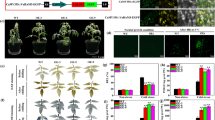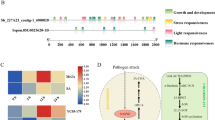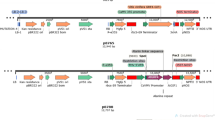Abstract
The cDNA clone of ascorbate oxidase gene was isolated from non-heading Chinese cabbage (Brassica campestris ssp. chinensis Makino, cv. Suzhouqing) and characterized. Sequence analysis showed that there was a high similarity between this sequence (named BcAO) and its homologues in other plant species. Southern blotting indicated that more than one nuclear gene encoded this enzyme in non-heading Chinese cabbage. The mRNA level of the BcAO gene in leaves was monitored by real-time PCR at different developmental stages and under different stress conditions. Results showed that the expression of BcAO was upregulated by light, and the BcAO gene responded to copper stress as well. After inoculation with Alternaria brassicae, the expression of BcAO in the leaves was increased in general and peaked at 12 and 72 h post inoculation, with much higher expression at the later date. Cloning the BcAO gene will enable us to further understand its function and would provide useful information for resistance breeding program for non-heading Chinese cabbage.
Similar content being viewed by others
Abbreviations
- AO:
-
ascorbate oxidase
- AsA:
-
ascorbic acid (ascorbate)
- hpi:
-
hours post inoculation
- ORF:
-
open reading frame
- RACE:
-
rapid amplification of cDNA ends
References
Kerchev, P.I., Pellny, T.K., Vivancos, P.D., Kiddle, G., Hedden, P., Driscoll, S., Vanacker, H., Verrier, P., Hancock, R.D., and Foyer, C.H., The transcription factor ABI4 is required for the ascorbic acid-dependent regulation of growth and regulation of jasmonate-dependent defense signaling pathways in Arabidopsis, Plant Cell, 2011, vol. 23, pp. 3319–3334.
Pastori, G., Kiddle, G., Antoniw, J., Bernard, S., Veljovic-Jovanovic, S., Verrier, P.J., Noctor, G., and Foyer, C.H., Leaf vitamin defense transcripts and regulate genes that control development through hormone signaling, Plant Cell, 2003, vol. 15, pp. 939–951.
Fotopoulos, V., Sanmartin, M., and Kanellis, A.K., Effect of ascorbate oxidase over-expression on ascorbate recycling gene expression in response to agents imposing oxidative stress, J. Exp. Bot., 2006, vol. 57, pp. 3933–3943.
Pignocchi, C., Kiddle, G., Hernández, I., Foster, S.J., Asensi, A., Taybi, T., Barnes, J., and Foyer, C.H., Ascorbate oxidase-dependent changes in the redox state of the apoplast modulate gene transcript accumulation leading to modified hormone signaling and orchestration of defense processes in tobacco, Plant Physiol., 2006, vol. 141, pp. 423–435.
Green, M.A. and Fry, S.C., Vitamin C degradation in plant cells via enzymatic hydrolysis of 4-O-oxalyl-Lthreonate, Nature, 2005, vol. 433, pp. 83–87.
Kato, N. and Esaka, M., Expansion of transgenic tobacco protoplasts expressing pumpkin ascorbate oxidase is more rapid than that of wild-type protoplasts, Planta, 2000, vol. 210, pp. 1018–1022.
Sanmartin, M., Drogoudi, P.D., Lyons, T., Pateraki, I., Barnes, J., and Kanellis, A.K., Over-expression of ascorbate oxidase in the apoplast of transgenic tobacco results in altered ascorbate and glutathione redox states and increased sensitivity to ozone, Planta, 2003, vol. 216, pp. 918–928.
Esaka, M., Fujisawa, K., Goto, M., and Kisu, Y., Regulation of ascorbate oxidase expression in pumpkin by auxin and copper, Plant Physiol., 1992, vol. 100, pp. 231–237.
Esaka, M., Uchida, M., Fukui, H., Kubota, K., and Suzuki, K., Marked increase in ascorbate oxidase protein in pumpkin callus by adding copper, Plant Physiol., 1988, vol. 88, pp. 656–660.
Xu, J. and Ye, H., Studies on the relationship between ascorbic acid oxidase and resistance of wheat to head blight, J. Sichuan Agric. Univ., 1998, vol. 16, pp. 319–321 (in Chinese).
Moser, O. and Kanellis, A.K., Ascorbate oxidase of Cucumis melo L. var. reticulatus: purification, characterization and antibody production, J. Exp. Bot., 1994, vol. 45, pp. 717–724.
Kato, N. and Esaka, M., cDNA cloning and gene expression of ascorbate oxidase in tobacco, Plant Mol. Biol., 1996, vol. 30, pp. 833–837.
Zou, L.P., Li, P., Yang, B., Zhang, J., and Ye, Z., Cloning and mapping of genes involved in tomato ascorbic acid biosynthesis and metabolism, Plant Sci., 2006, vol. 170, pp. 120–127.
Ohkawa, J., Okada, N., Shinmyo, A., and Takano, M., Primary structure of cucumber (Cucumis sativus) ascorbate oxidase deduced from cDNA sequence: homology with blue copper proteins and tissue-specific expression, Proc. Natl. Acad. Sci. USA, 1989, vol. 86, pp. 1239–1243.
Lin, L.S. and Varner, J.E., Expression of ascorbic acid oxidase in zucchini squash (Cucurbita pepo L.), Plant Physiol., 1991, vol. 96, pp. 159–165.
Letunic, I., Copley, R.R., Schmidt, S., Ciccarelli, F.D., Doerks, T., Schultz, J., Ponting, C.P., and Bork, P., SMART 4.0: towards genomic data integration, Nucleic Acids Res., 2004, vol. 32, pp. 142–144.
Liu, T., Hou, X., Zhang, J., Song, Y., Zhang, S., and Li, Y., A cDNA clone of BcHSP81-4 from the sterility line (Pol CMS) of non-heading chinese cabbage (Brassica campestris ssp. chinensis), Plant Mol. Biol. Rep., 2011, vol. 29, pp. 723–732.
Livak, K.J. and Schmittgen, T.D., Analysis of relative gene expression data using real-time quantitative PCR and the 2-ΔΔCT method, Methods, 2001, vol. 25, pp. 402–408.
De Tullio, M.C., Ciraci, S., Liso, R., and Arrigoni, O., Ascorbic acid oxidase is dynamically regulated by light and oxygen. A tool for oxygen management in plants? J. Plant Physiol., 2007, vol. 164, pp. 39–46.
Acton, G.J., Drumm, H., and Mohr, H., Control of synthesis de novo of ascorbate oxidase in the mustard seedling (Sinapis alba L.) by phytochrome, Planta, 1974, vol. 121, pp. 39–50.
Arrigoni, O., Chinni, E., Ciraci, S., and de Tullio, M.C., In vivo elicitation of ascorbate oxidase activity by dioxygen and its possible role in photosynthesizing leaves, Rend. Fis. Acc. Lincei, 2003, vol. 14, pp. 127–134.
Miller, L.L., Miller, S.C., Torti, S.V., Tsuji, Y., and Torti, F.M., Iron independent induction of ferritin H chain by tumor necrosis factor, Proc. Natl. Acad. Sci. USA, 1991, vol. 88, pp. 4946–4950.
Kaegi, J.H.R. and Schaeffer, A., Biochemistry of metallothionein, Biochemistry, 1988, vol. 27, pp. 8509–8515.
Shatzman, A.R. and Kosman, D.J., The utilization of copper and its role in the biosynthesis of copper-containing proteins in fungus Dactylium dendroides, Biochim. Biophys. Acta, 1978, vol. 544, pp. 163–179.
Li, Y., Song, Y.P., Shi, G.J., Wang, J.J., and Hou, X.L., Response of antioxidant activity to excess copper in two cultivars of Brassica campestris ssp. chinensis makino, Acta Physiol. Plant., 2009, vol. 31, pp. 155–162.
Doughty, K.J., Porter, A.J.R., Morton, A.M., Kiddle, G., Bock, C.H., and Wallsgrove, R., Variation in the glucosinolate content of oilseed rape (Brassica napus L.) leaves. 2. Response to infection by Alternaria brassicae (Berk) Sacc., Ann. Appl. Biol., 1991, vol. 118, pp. 469–477.
Berto, P., Comménil, P., Belingheri, L., and Dehorter, B., Occurrence of a lipase in spores of Alternaria brassicae with a crucial role in the infection of cauliflower leaves, FEMS Microbiol. Lett., 1999, vol. 180, pp. 183–189.
Author information
Authors and Affiliations
Corresponding author
Additional information
This text was submitted by the authors in English.
Rights and permissions
About this article
Cite this article
Ren, J., Gao, H., Zhou, J. et al. Molecular cloning and characterization of ascorbate oxidase gene in non-heading Chinese cabbage. Russ J Plant Physiol 60, 756–763 (2013). https://doi.org/10.1134/S1021443713060113
Received:
Published:
Issue Date:
DOI: https://doi.org/10.1134/S1021443713060113




